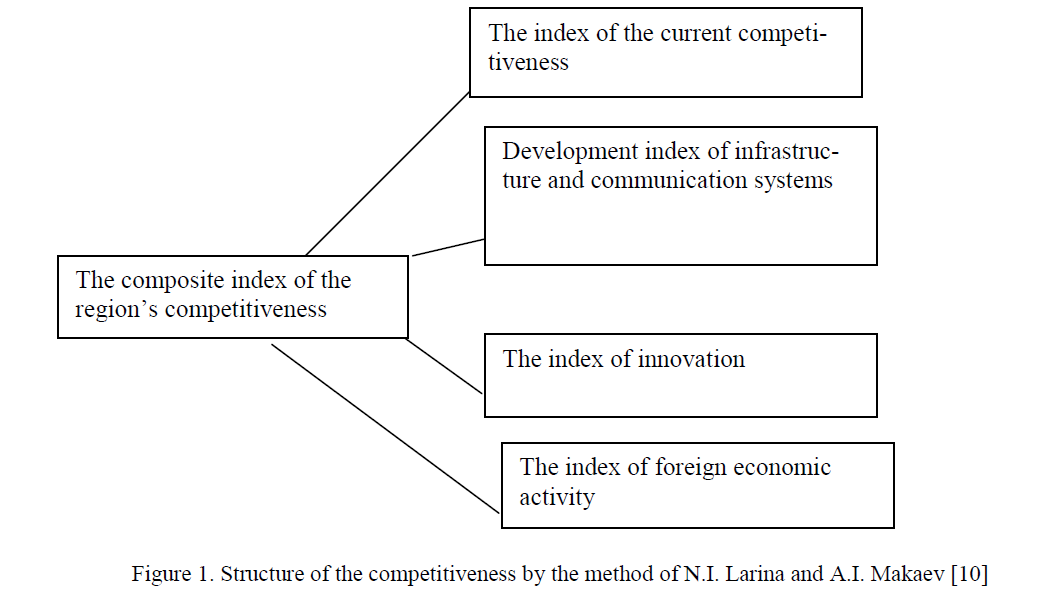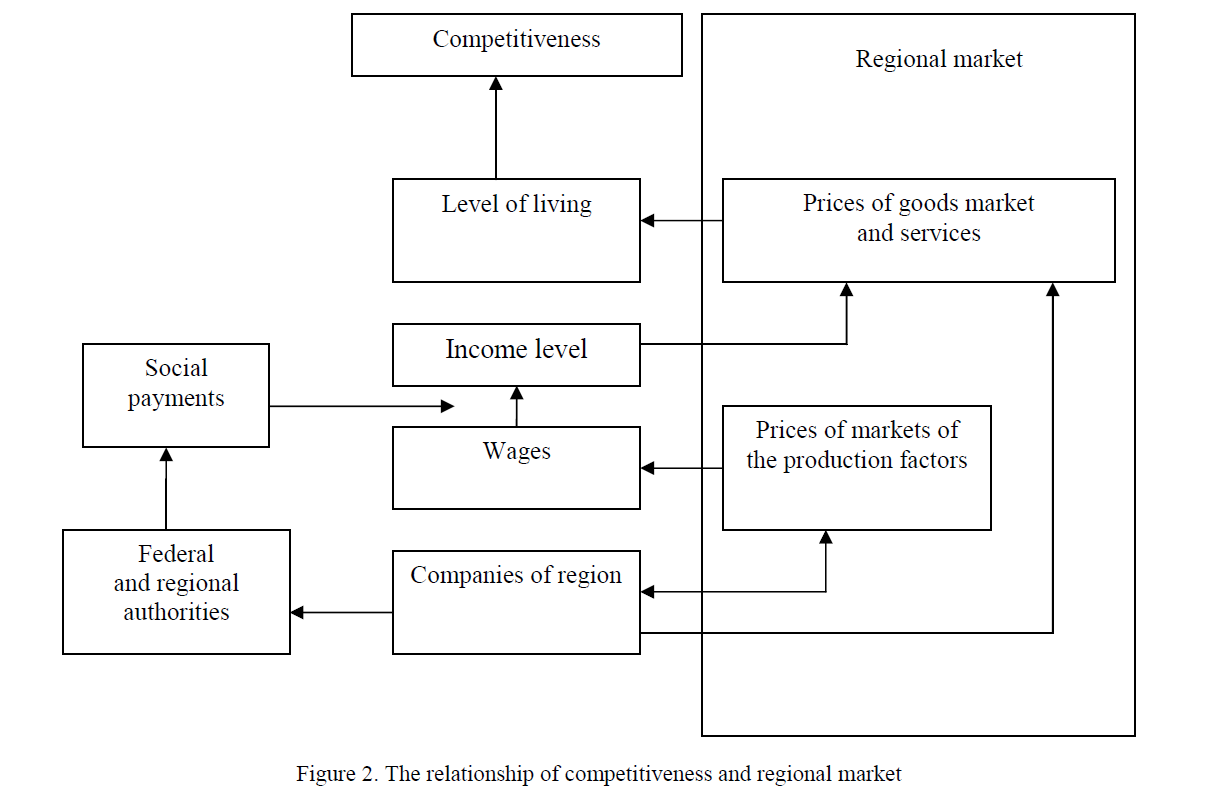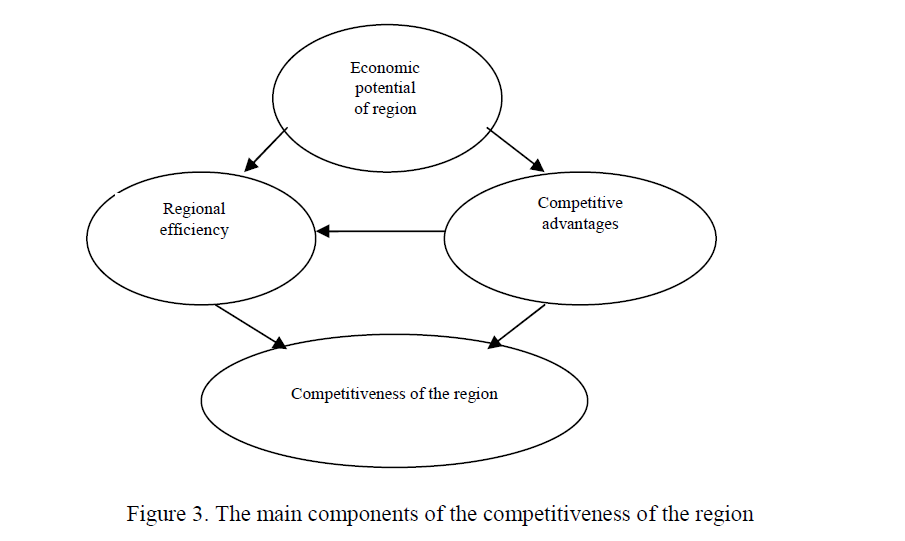This article presents an analysis of the methodological tools for evaluation of regional competitiveness. The subject of the analysis are developments of Russian scientists, including Uralian and Siberian schools of regionalists, as well as research conducted in this field by Porter, where common denominators and differences in the interpretation of the main components of a region’s competitiveness and factors that radically affect it have been identified. On the basis of study of the theoretical views of leading scientists on the concept of «competitiveness of the region», the existing methods of evaluating the level of economic development of countries and regions, the authors conclude that all existing methods use an integrated approach in the assessment of competitiveness, each of them has both its advantages and disadvantages. The most advanced methods in the calculation of their indicators are based on comparative rating of the countries and regions of foreign authors, and do not take into account the interests of manufacturers of the industry. They mostly cover only the socioeconomic development of the region. Therefore, the methodological tools of competitiveness are under-development.
The degree of competitiveness of region of each country has its own special structure, and is based on various factors. To evaluate the factors in the formation of regional competitiveness in general and the possibility of exposure to regional authorities on its components it is advisable to use the model of the «national rhombus» proposed by M. Porter for the country [1; 284]. The region's role in the creation of competitive advantages of firms can be studied in four interrelated areas (determinants), forming a «regional diamond»: parameters factors (natural resources, skilled human resources, capital, infrastructure, etc.); demand conditions (income elasticity of demand, demanding customers in the quality of goods and services, and others.); related and supporting industries (company provide the necessary resources, components, information, banking, insurance and other services); company strategy, structure and rivalry between them (create a competitive environment and develop a competitive advantage). In turn, each of the determinants analyzed by components, their impact on the competitive advantage of the region, as well as the need for their development.
A.Z. Seleznev offers thirty indicators determining regional competitiveness: the power produced in the region of raw materials, fuel and energy resources; provision of production, market and social infrastructure; degree of deterioration of the equipment and the prospects for its replacement; remoteness of suppliers and consumers of the bulk import and export (at least 60% of the volume); availability of transport highways, sea and river ports, global communications infrastructure; the environmental situation; availability of highly qualified staff, and so on. [2; 139]. N.Ya. Kalyuzhnov proposes to consider the competitiveness of the region with three positions [3]:
- Competitive advantages (advantageous position of the region in the competitive interaction with other regions).
- Competitive position of the region (identified for the region-specific conditions (features) that define the most important features of the regional target markets for consumers).
- Competitive resources (a set of tangible and intangible elements of the region, which have a market value or increase the demand on the other elements of the region and can be used to create a competitive advantage in the region and achieve competitive success).
World experts, as R.Z. Lawrence, have long engaged in the challenge of assessing countries’ and regions’ competitiveness in the world market. American scientists R. Farmer and B. Richman characterize competitiveness through the use of a matrix, which consists of four groups of factors:
- Political and legal
- Education
- Social and cultural
- Economic [4].
Then each of these «independent variables» were mapped to functions such as planning, marketing and production. However, this method is too complicated and has not found wide application.
However, this concept has been used in the methodology for determining the level of competitiveness of the country, developed by experts of the International Institute for Management Development and dubbed «cube competitiveness».
From the economic perspective under the region should be understood as «geographically specific part of the national economy, characterized by unity and integrity of the reproductive process» [5].
Different definitions of the region at different times are given by scholars such as Izard, R. Taylor, Richardson, A. Granberg, I. Suslov [6, 7].
However, in the modern sense of the essence of the region, there are two approaches:
- The region as a
- The region as a social
According to G.A. Untura, we can distinguish six different structures in the region: the power structure, business, commercial, financial and credit structure, infrastructure, population.
N.Ya. Kalyuzhnov [3; 427] identifies three main groups of economic actors in the region — government, business, people, the interested objects of which are taxes, profits and wages. The methodology proposed by M. Porter for evaluating clusters, formed the basis for the world ranking of competitiveness as defined by the world economic forum. Cluster approach to the analysis of the structure of the economy has been applied in the development of industrial policy in many countries since 1995.
The potential competitiveness of a region were recorded if the growth rate in sales, profits and investment, as well as the level of labor productivity in the sector is higher than the average in the world [8; 540].
Countries may be in unequal position in varying degrees due to the international exchange rate as well in tandem with their related global share of production and consumption. The US and Japan are not dependent on international trade than Western Europe. Dependency of on export is particularly greater when a country offers a few specific products for export — for example, Kazakhstan is almost totally dependent on export of its oil, ferrous and nonferrous metals, grains for the national revenue [9; 71].
Regional competition is a powerful driving force in improving the efficiency of the national economy and plays a vital role in development. Hence, improvement of methodological approaches to assess the regional economy.
Such improved and tailor-made methodology would furnish us with the ability of in depth analysis of the competitiveness of a cluster of region (not individual cities and enterprises), which in turn would allow us to form an as accurate as possible idea about the real state of the competitiveness of the country in question as a whole.
The first work on the evaluation of contributing factors in relation to regional competitiveness was the work of G. Untura called «Competitive Positions», which studied the case of the Kemerovo region in Russian Federation.
The most common way to date, in country-comparison is ratings of studied countries. Rating of the country is favorable conditions for business by organizing a collective evaluation obtained by the country in terms of distance from the forward line in ten directions. Each of the areas is composed of several indicators having a value equal to the indicator.
The first stage of evaluations selection of rating indicators that characterize the competitiveness of a particular region. At the same stage data collection and analysis takes place. The second step is the accumulation of points for each indicator, then shape the scale (for this, indicator usually leads to a dimensionless form). The third step is the aggregation of intermediate outcome indicators. It usually represents the arithmetic mean of the indices calculated in the second phase of the research. The closest to the country's rating methodology is a technique [10, 2–26]. Calculated index strategic competitiveness, which is based on four groups of indicators: overall economic performance (GRP, retail trade turnover); external relations of the regions (density of railways, the availability of telephone and cellular); innovative potential; foreign trade relations and investment attractiveness of the region (Figure 1).
The composite index of competitiveness is calculated as the arithmetic average of the current and strategic competitiveness.

Figure 1. Structure of the competitiveness by the method of N.I. Larina and A.I. Makaev [10]
The technique of L.I. Ushvitskiy and V.N. Parakhina (Tablе 1) uses the concept of assessing the competitiveness of the region, based on 3 components: the standard of living of the population, the investment attractiveness of the region and the efficiency of resource use. This technique allows obtaining a qualitative and quantitative evaluation of the parameters of competitiveness.
T a b l e 1
Key figures included in the integral level of competitiveness by the method of L.I. Ushvitskiy and V.N. Parakhina
|
Title of indicators |
Unit of measure |
|
Indicators of investment attractiveness and activity of the region K in |
|
|
1 Fixed capital expenditure |
mil.rub |
|
2 Investments per 1 ruble of gross regional product |
rub. |
|
3 Index of physical volume of investments |
% |
|
4 Investments in fixed assets per capita |
Thous.ruble/person |
|
Indicators of living standards in the region К |
|
|
1 Provision of housing and / or housing investment |
м2/per |
|
2 Average monthly salary of worker |
rub/per |
|
3 Unemployment rate |
% |
|
4 The minimum subsistence level |
rub/per |
|
5 The volume of paid services to the population |
rub/per |
|
Indicators of living standards in the region К |
|
|
6 Incomes of the population of the region |
rub/per |
|
7 The share of the poor people |
% |
|
8 Number of recorded crimes per 10 thousand inhabitants |
unit |
|
Indicators of availability and efficient use of resources in the region К |
|
|
1 Volume of GRP |
rub/per |
|
2 The rate of change of volume of GRP |
% |
|
3 The share of loss-making companies |
% |
|
4 Retail sales |
rub/per |
|
5 Export products to the far and near abroad |
US dollars/per |
|
6 Density of motor roads of general purpose |
km roads/1000 кm2 |
V.V. Pechatkin, S.U. Salihov, V.A. Sablin believe that the competitiveness of the region — the ability to consistently produce and consume goods and services in competition with the goods and services produced in other regions. In their research evaluation makes by multivariate correlation-regression analyses.
Integral indicator of competitiveness includes the following indicators: the region's ability to produce goods and services in a competitive environment; characterization of the quality of life of the population. On the basis of the obtained data conducts ranking of regions in terms of competitiveness [11].
Andreev V.E. believes that the competitiveness of the region is provided, primarily by improving the quality of life and competitiveness as regards the possibility of providing a high standard of living at the expense of the region's capacity (labor, raw materials, innovation, etc.) [12; 20].
V.E. Andreev’s general scheme of the approach to the evaluation of competitiveness is presented in Figure 2.

Figure 2. The relationship of competitiveness and regional market
Evaluation is performed by the use of functional dependence based on 4 components:
FP — the presence, distribution and functional orientation of the main factors of production in the region (labor, minerals, branch structure of capital);
Y — the standard of living of the population of the region (the level of employment, income and differentiation);
SP — socio-political factors that characterize the interaction of key actors of the regional market — administration, public, business, relationships with the federal center.
As a result, the competitiveness is described by a complex multivariate model, which can be represented as:
RC = f (Y, I)
Thus, according to V.E. Andreev from the variety can be identified a core group of factors drastically affects the performance of the region's competitiveness, namely:
Y — the index of the standard of living of the population in the region; I — investment attractiveness;
In the evaluation method of V.V. Merkushov calculated integral assessment of competitiveness based on three particular scorecards: economic potential, regional efficiency and competitive advantage [13; 38]. According to V.V. Merkushov competitiveness is based on the following indicators (Figure 3)

Figure 3. The main components of the competitiveness of the region
According to V.V. Merkushova analysis of the competitiveness of the region makes sense only if the comparison of the states of the object at different moments (intervals) of time, or when comparing the studied object with comparable objects competitors.
Researchers such as S.G. Vazhenin, A.R. Zlochenko, A.I. Tatarkin evaluate the competitiveness of macro-regions in the following parameters of their economic behavior: labor costs and their structure, the intensity of the renewal of fixed assets, investment market conditions, the innovative mobility.
S.V. Kazantsev proposes to evaluate the competitiveness of the regions in relation to the gross regional GDP in per capita terms. Thus, analysis of existing today, methodical approaches to the study of regional competitiveness has revealed that the currently existing techniques do not fully allow us to estimate the competitiveness from the point of view of different actors in the region, taking into account their goals. The results are shown in Table 2 [14, 15].
T a b l e 2
Comparative characteristics of methods of assessing the competitiveness
|
Methods of assessment of competitiveness |
Dignity |
Shortcomings |
|
1 |
2 |
3 |
|
Integral assessment of the competitiveness S.U. Salihov, V.V. Pechatkin, V.A. Sablin |
1. Access to the information base. 2. Conducting of approbation |
1. A large number of indicators for evaluation. 2. There is no concept of assessing the competitiveness of the region. 3. Complex mathematical apparatus. |
|
V.E. Andreev’s Comprehensive multifactorial assessment of the competitiveness of the region |
1. Access to the information base. 2. There is a structured approach to the assessment of the competitive- ness of the region. |
1. The methodology relies mainly on price levels of the regional market. This approach is subjective. 2. Lack of social indicators. 3. Requires expert evaluation |
|
V.V. Merkushov’s Integral assessment of the competitiveness of regions |
1. The ternary system of indicators to assess the competitiveness 2. Fully covers the economic development of the region. 3. Accessibility of information base |
1. Lack of indicators of social orientation 2. Methodology shows only the overall economic development |
|
L.I. Ushvitskiy and V.N. Parakhina’s Integral assessment of the competitiveness of regions |
1. Formulated a clear concept of assessing the competitiveness of the region 2. Availability of information base |
1. There isn’t substantiated list of indicators that characterize the competitiveness of region 2. Lack of systematic approach in selecting indicators. |
|
1 |
2 |
3 |
|
N.I. Larina and A.I. Makaev’s Overall assessment of the competitiveness of regions |
1. The closest to the popular country rating methodology, taking into account the specifics of the Russian Federation. 2. Availability of information base 3. Easiness of mathematical calculations |
1. There isn’t substantiated list of indicators that characterize the region's competitiveness 2. Methodology shows only the overall economic development |
In general, it can be noted that the above mentioned all procedures using an integrated approach to evaluating the competitiveness; each of them has both advantages and disadvantages. Most modern techniques, according to its design parameters are based on the comparative ratings of the countries and regions of foreign authors. From the point of view of N.Ya. Kalyuzhnov, ranking approach and comparative ratings of the typical «western methodology», where there is a desire to expose the participants evaluation of the competitive process and compare their criteria for different positions. Thus, we can conclude that the methodological tools of competitiveness are under development. The most methods do not take into account the interests of the industry producers in the region, mostly they cover only the socio-economic development of the region.
References
- Porter Competition, Saint Petersburg: Publ. house Williams, 2003, 494 p.
- Seleznev Z. Competitive position and the Russian market infrastructure, Moscow: Yurist, 1999, 139 p.
- Regions Competitiveness: Theoretical and Applied Aspects, by prof., D.e.c. Yu.K. Persky, D.e.c, Assoc. N.Yа. Kalyuzhnov, Moscow: TEIS, 2003, 427 p.
- Lawrence Z. Competitiveness. The Concise Encyclopedia of Economics Library of Economics and Liberty. attach. by:M.E. Shaihutdinov, Almaty: Institute of World Economics and Politics under the Foundation of the First President of Kazakhstan, 2008.
- Regional Economy, textbook: by prof. V.I.Vidyapin, prof. M.V. Stepanov, Moscow: Infra-M, 665 p.
- Izard Methods of Regional Analysis: An Introduction to the Science of regions / U.Izard, Мoscow: Progress, 1966.
- Granberg A.G. Optimization of territorial proportion of the national economy, Мoscow: Economy,
- Territorial competition in the economic area, ed. by Vazhenin S.G., Bersenev V.L., Vazhenin I.S., Tatarkin A.I., Ekaterinburg: Institute of Economics UB RAS, 2011, 540
- Ivanov D. Agroinfo, 2008, 11, p. 71. 10 Larina N.I. Eco, 2006, 10, p. 2–26.
- Pechatkin V. Institute of Social and Economic Research, Ufa Scientific Center RAS, Ufa, 2004.
- Andreev V.E. Economy and Life, 2005, 12, p. 3–10.
- Merkushov V. Inter-regional economic comparisons: a collection of articles, Мoscow, 2004, p. 24–38.
- The competitiveness of the region: new trends and challenges, ed. by Corresponding member of RAS A.I. Tatarkin, Ekaterinburg: Institute of Economics UB RAS, 2003, 232 р.
- Ushvitsky L.I. A collection of articles of Economy, Vladikavkaz: North-Caucasian University, 2005, 1, p. 1–20.